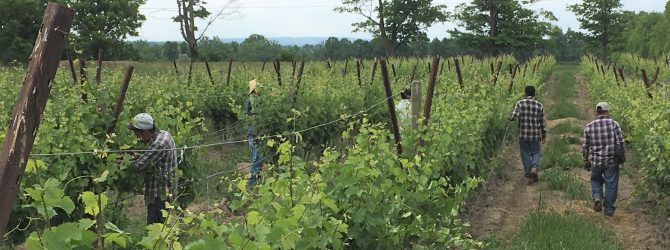June 13th was a glorious spring day in the Finger Lakes wine country, the sun was shining and the vines were growing vigorously. I had the pleasure of spending some time in the field with Tim Martinson, viticulture specialist with Cornell, to visit with growers about labor issues. We visited three growers at their farms and then joined a group of six other growers and industry professionals for lunch and further discussion.
Several themes became very clear about labor challenges and needs in the Finger Lakes grape industry:
- Labor is a major issue of concern and strongly influences both short- and long-term business decisions. It is hard to find employees both for front-line positions and for middle manager or supervisory positions.
- Front-line vineyard work has evolved dramatically over the years, from local labor, to migrant crews, and increasingly to guest workers through federal programs such as H2A. Today there is great diversity in how vineyards get the work done.
- The industry is able to attract some young people into it as a career. Many of these people work for a few years at a winery and then find plenty of career-advancing opportunities to move on and become winemakers or vineyard owners elsewhere.
- A consortium of growers has learned to have much success cooperating to bring in guest workers using the H2A program. Even so, communication is very critical and there are times when multiple growers need workers at the same time.
- There are major differences between hourly work and piece rate work. Piece rates give growers better predictability in costs, hourly work has the potential for higher quality results. Regardless of pay structure, management always has an impact on performance and quality.
- Mechanization is a partial answer to tight labor supplies, but there remain many tasks that can only be performed by human hands.
The Cornell Agricultural Workforce Development Program will begin to work with specialists, growers, and the wider industry to identify workforce challenges facing the Finger Lakes grape industry, and to seek solutions.
__________________________________________________________________
By Richard Stup, Cornell University. Permission granted to repost, quote, and reprint with author attribution.
The post A Look at Labor in the Vineyard appeared first on Cornell Agricultural Workforce Development.


